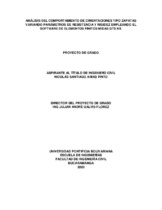Mostrar el registro sencillo del ítem
Análisis del comportamiento de cimentaciones tipo zapatas variando parámetros de resistencia y rigidez empleando el software de elementos finitos midas GTS NX.
| dc.contributor.advisor | Director. Galvis Flórez, Julián André | |
| dc.contributor.author | Arias Pinto, Nicolás Santiago | |
| dc.coverage.temporal | 2020 | |
| dc.date.accessioned | 2021-11-25T17:03:16Z | |
| dc.date.available | 2021-11-25T17:03:16Z | |
| dc.date.issued | 2020-07 | |
| dc.identifier.uri | http://hdl.handle.net/20.500.11912/9692 | |
| dc.description | 15p.: (pdf); il; imágenes; tablas; gráficas. | spa |
| dc.description.abstract | Este proyecto de grado presenta un análisis investigativo, en el cual se ilustra el comportamiento de los tipos de suelos alterando sus parámetros de resistencia y rigidez. Para ello, el presente documento contó con una fase inicial de calibración del software donde se dio a conocer el alcance de las herramientas tecnológicas. Seguidamente, se realizó una tabla de datos con base a parámetros de suelos existentes, para así establecer intervalos de alteración en Modulo de elasticidad, Peso específico, Coeficiente de poisson, ángulo de fricción, Cohesión; en aquel ejercicio se le dio un valor a cada ítem, agregando unas posibles combinaciones, que dieron como fruto un número de modelación, para así proceder a realizar las modelaciones ajustadas a un tipo de suelo diferente. Unido a lo anterior, se realizó la fase de ejecución -modelación- en el software MIDAS GTS NX, donde los resultados obtenidos fueron tabulados, graficados y analizados por capacidad de asentamiento. En la fase final, se demostró que para cimentaciones superficiales tipo zapata modeladas en este tipo de software, de elementos finitos, el parámetro que tiene más ponderancia, al momento de realizar un diseño de cimentación, es el módulo de elasticidad. | spa |
| dc.description.abstract | This degree project presents a research analysis, which illustrates the behavior of soil types by altering their resistance and stiffness parameters. For this, the present document had an initial phase of software calibration where the scope of the technological tools was presented. Subsequent, a data table was made based on existing soil parameters to establish alteration intervals in Modulus of elasticity, Specific weight, Poisson\'s coefficient, Angle of friction, and Cohesion; in that exercise, a value was given to each item, adding some possible combinations, which resulted in a modeling number, in order to proceed to perform the modeling adjusted to a different type of soil. Furthermore, the execution-modeling phase was carried out in the Midas GTS NX software, where the results obtained were tabulated, plotted and analyzed by settlement capacity. In the final phase, it was shown that for the footing type surface foundations modeled, in this type of finite element software, the parameter that has more weight, when making a foundation design, is the modulus of elasticity. | eng |
| dc.format.mimetype | application/pdf | |
| dc.language.iso | spa | |
| dc.publisher | Universidad Pontificia Bolivariana | spa |
| dc.rights | Attribution-NonCommercial-NoDerivatives 4.0 International | * |
| dc.rights.uri | http://creativecommons.org/licenses/by-nc-nd/4.0/ | * |
| dc.subject | Cimientos | spa |
| dc.subject | Resistencia de materiales | spa |
| dc.subject | Rigidez | spa |
| dc.subject | Método de elementos finitos | spa |
| dc.subject | Software -Midas GTS NX | spa |
| dc.subject | Elasticidad | spa |
| dc.title | Análisis del comportamiento de cimentaciones tipo zapatas variando parámetros de resistencia y rigidez empleando el software de elementos finitos midas GTS NX. | spa |
| dc.type | Trabajo de grado | spa |
| dc.publisher.department | Escuela de Ingenierías | spa |
| dc.publisher.program | Ingeniería Civil | spa |
| dc.type.hasVersion | publishedVersion | spa |
| dc.description.sectional | Bucaramanga | spa |
| dc.description.degreename | Ingeniería Civil | spa |
Ficheros en el ítem
Este ítem aparece en la(s) siguiente(s) colección(ones)
-
Trabajos de grado [6055]
Monografías, artículos, informes, proyecto de grado


